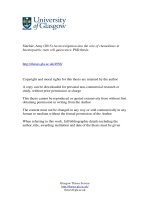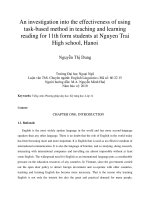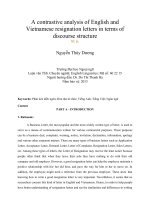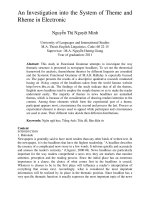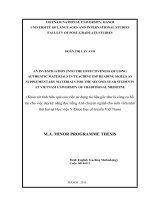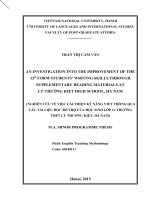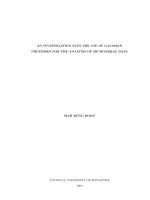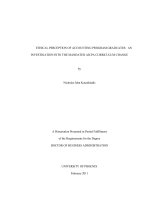AN INVESTIGATION INTO THE IMPROVEMENT OF THE 12th FORM STUDENTS’ WRITING SKILLS THROUGH SUPPLEMENTARY READING MATERIALS
Bạn đang xem bản rút gọn của tài liệu. Xem và tải ngay bản đầy đủ của tài liệu tại đây (801.73 KB, 92 trang )
VIETNAM NATIONAL UNIVERSITY, HANOI
UNIVERSITY OF LANGUAGES AND INTERNATIONAL STUDIES
FACULTY OF POST-GRADUATE STUDIES
TRẦN THỊ CẨM VÂN
AN INVESTIGATION INTO THE IMPROVEMENT OF THE
12
th
FORM STUDENTS’ WRITING SKILLS THROUGH
SUPPLEMENTARY READING MATERIALS AT
LÝ THƯỜNG KIỆT HIGH SCHOOL, HÀ NAM
(NGHIÊN CỨU VỀ VIỆC CẢI THIỆN KỸ NĂNG VIẾT THÔNG QUA
CÁC TÀI LIỆU ĐỌC BỔ TRỢ CỦA HỌC SINH LỚP 12 TRƯỜNG
THPT LÝ THƯỜNG KIỆT, HÀ NAM)
M.A. MINOR PROGRAMME THESIS
Field: English Teaching Methodology
Code: 60140111
Hanoi, 2015
VIETNAM NATIONAL UNIVERSITY, HANOI
UNIVERSITY OF LANGUAGES AND INTERNATIONAL STUDIES
FACULTY OF POST-GRADUATE STUDIES
TRẦN THỊ CẨM VÂN
AN INVESTIGATION INTO THE IMPROVEMENT OF
THE 12
th
FORM STUDENTS’ WRITING SKILLS THROUGH
SUPPLEMENTARY READING MATERIALS AT
LÝ THƯỜNG KIỆT HIGH SCHOOL, HÀ NAM
(NGHIÊN CỨU VỀ VIỆC CẢI THIỆN KỸ NĂNG VIẾT THÔNG QUA
CÁC TÀI LIỆU ĐỌC BỔ TRỢ CỦA HỌC SINH LỚP 12 TRƯỜNG
THPT LÝ THƯỜNG KIỆT, HÀ NAM)
M.A. MINOR PROGRAMME THESIS
Field: English Teaching Methodology
Code: 60140111
Supervisor: Dr. Phạm Đăng Bình
Hanoi, 2015
DECLARATION
I declare that this thesis and the work presented in it are my own and
have been generated by me as the result of my own original research.
I confirm that this thesis is submitted in partial fulfillment of the
requirement for the degree of Master of Arts and that this thesis has not
previously been submitted for a degree or any other qualification at any other
universities or institutions.
Hanoi, April, 2015
Trần Thị Cẩm Vân
i
ACKNOWLEDGEMENTS
First, I would like to express my sincere thanks to my supervisor Dr.
Phạm Đăng Bình for his generous assistance and guidance, especially for his
sympathy throughout the research process.
My special thanks go to all the teachers in the faculty of Post Graduate
Studies, University of Languages and International Studies for their useful
lectures, materials, guidance and enthusiasm during my course.
I also highly appreciate the cooperation of my colleagues and Class
12A1 and Class 12D1 students at Lý Thường Kiệt High School in Ha Nam.
Last, I would like to express my gratitude to my family and my friends,
who have always encouraged me and supported me to fulfill this study.
ii
ABSTRACT
The primary aim of this study is to evaluate the effects of integrating
supplementary reading materials in writing lessons of the 12
th
form students at
Ly Thuong Kiet high school. Along with it, the most popular difficulties and
possible suggestions to enhance students’ writing skills through reading
would be discussed.
The study revolves an experimental research with the participation of 5
teachers and 90 students of 12
th
form at Lý Thường Kiệt High School, Ha
Nam province. To collect data for this study, two pre-task questionnaires, two
post-task questionnaires, a pre-test and a post-test were employed. After
examining the responses from the pre-task questionnaires, the author designed
and integrated a set of nine supplementary reading texts and respective
reading and writing exercises into writing lessons of 45 experimental students
in 9 weeks of the first semester of the school year 2014-2015. During the
same time, 45 students of the control group only received writing exercises.
The results from the post-task questionnaires, the pre-test and post-test
showed that there had been a significant improvement in the students’ writing
skill in terms of vocabulary, ideas and organization after they took part in the
supplementary reading integration programme in comparison with the
students of control group. Moreover, most of students of the experimental
group acknowledged the benefits of the supplementary reading integration
programme and expected that such programme would be applied in the future.
iii
LIST OF ABBREVIATIONS
EFL : English as a Foreign Language
ESL : English as a Second Language
MOET : Ministry of Education and Training
LIST OF TABLES
Table 1: Students' Writing Proficiency 22
LIST OF FIGURES
Figure 1: Class 12A1 and Class 12D1 Pre-test Score 25
Figure 2: Class 12A1 and Class 12D1 Post-test Score 26
Figure 3: Opinions on role of writings skill in learning English 27
Figure 4: Opinions on time spent for writing skill at school 28
Figure 5: Students' Writing Practice Frequency 28
Figure 6: Difficulties that students encounter when writing 29
Figure 7: Methods Teachers use to instruct students to develop their
writing skill 29
Figure 8: Opinion on effect of the supplementary reading integration
programme 30
Figure 9: Benefits that students could gain from the supplementary
reading integration programme 31
Figure 10: Continue designing supplementary reading materials to
develop students' writing skill or not 32
Figure 11: Tasks students should do 32
Figure 12: Tasks teachers should do 33
TABLE OF CONTENTS
Declaration i
Acknowledgements ii
Abstract iii
iv
List of Abbreviations iv
List of Tables iv
List of Figures
TABLE OF CONTENTS
iv
v
PART A: INTRODUCTION 1
1. Statement of the Problem 1
2. Aims of the study 1
3. Research questions 1
4. Scope of the study 2
5. Significance of the study 3
6. Method of the study 3
7. Design of the study 3
PART B: DEVELOPMENT 4
CHAPTER 1: LITERATURE REVIEW 4
1.1. Definitions of Writing 4
1.1.1. What is Writing? 4
1.1.2. Rationale behind teaching Writing 5
1.1.3. Approaches to Writing Instruction 6
1.1.3.1. Text-Centred Approach 6
1.1.3.2. Writer-Centred Approach 8
1.1.3.3. Reader-Centred Approach 9
1.2. Definitions of Supplementary Reading Materials 9
1.2.1. What is Supplementary Reading Materials? 9
1.2.2. Suitable Supplementary Reading Materials for EFL
Teaching and Learning Process 11
1.2.3. The Influence of Reading on Writing 12
1.2.4. Researches on Adopting Reading Materials to Enhance
Writing 13
1.3. Conclusion 14
CHAPTER 2: RESEARCH METHODOLOGY 16
2.1. Investigation Context 16
2.2. Participants 16
2.3. Data Collection Instruments 17
2.3.1. Questionnaires 17
2.3.1.1.Student Questionnaires 17
2.3.1.2.Teacher Questionnaires 17
2.3.2. Pre-Test and Post-Tests 18
2.4. Scoring Rubric for Writing ……………………………………. 18
v
2.5. Experimental Intervention: Supplementary Reading Material
Integration
21
2.5.1. The Supplementary Reading Materials 21
2.5.2. Supplementary Reading Material Integration Procedure 21
CHAPTER 3: RESULTS AND DISCUSSIONS 22
3.1. Analysing Writing Test Results 22
3.1.1. Analysis of Writing Proficiency 22
3.1.1.1. Analysis of Word Choice 22
3.1.1.2. Analysis of Convention 23
3.1.1.3. Analysis of Coherence 23
3.1.1.4. Analysis of Ideas 23
3.1.1.5. Analysis of Organization 24
3.1.1.6. Analysis of Writing Test Scores 25
3.2. Evaluating Responses from Questionnaires 27
3.2.1. Evaluation of Responses from Pre-task Questionnaires 27
3.2.2. Evaluation of Responses from Post-task Questionnaires 30
3.3. Summary 35
PART C: CONCLUSION 34
1. Conclusion on Major Findings 35
2. Pedagogical Implications 36
3. Limitations of the Study 36
4. Suggestions for Further Studies 37
REFERENCES 38
APPENDICES I
vi
vii
PART A: INTRODUCTION
1. Rationale
Although writing is an important skill in teaching and learning English,
it seems to be undervalued inside the classroom. The neglect of this skill
causes the 12
th
graders at Ly Thuong Kiet (LTK) high school to be weak and
poor writers though writing is a compulsory part in the national GCSE
examination. It is noticed that English teachers in LTK high school often use
a methodology based on teacher-talk and note-taking practices, mainly
explaining some new words and structures before asking students to write.
Therefore, the 12
th
students could not express well in English due to the lack
of format instruction, useful language, topic background, idea organization,
etc.
Among many methods of improving students’ writing skill, integrating
two language skills, reading and writing has been proved to have positive
effects on students’ writing skills in many researches. Brown (1987) stated
that “by reading and studying a variety of relevant types of text, students can
gain important insights both about how they should write and about subject
matter that may become the topic of their writing”. Reading inspires students,
helps them to think critically and analytically. Reading also provides students
with ideas for their essays because they often lack the experience for complex
subjects. Moreover, reading supplies grammar, syntax, language or
organization for students as a model. Despite many advantages, this method
hasn’t been deployed in the context of high school in Vietnam.
All these mentioned reasons above have inspired the researcher to carry
out the study titled “An investigation into the improvements of the 12
th
form
students’ writing skills through supplementary reading materials at Lý
1
Thường Kiệt High School, Hà Nam” as an attempt to help improve writing
skills of students.
2. Aims of the Study
This study aims to evaluate the effects of integrating supplementary
reading materials in writing lessons of the 12
th
form students at LTK high
school. Therefore, the researcher’s first objectives are to find out the
difficulties the students are facing, and how much the new method helps
improve their writing. A number of lessons which are planned based on this
method will be applied in classroom for a period of time to answer that
question. In addition, some practical suggestions and strategies will be
recommended to teachers at LTK high school with a view of making full use
of reading supplementary materials in writing lessons.
3. Research Questions
In short, the study is designed to answer the following questions:
1. What possible problems are the 12
th
form students at Ly Thuong Kiet
High School faced with in writing?
2. To some extent can the application of reading supplementary
materials have effects on students’ writing proficiency?
3. What are the possible suggestions to enhance students’ writing skills
at Ly Thuong Kiet high school?
4. Scope of the study
Due to the time constraints and content of a minor thesis, the research
attempts to investigate the effects of supplementary reading materials on
writing proficiency of two 12
th
form classes at LTK high school in 9 weeks.
The researcher will employ 90 students and 5 teachers of English for
collecting data.
2
5. Significance of the study
This study could be some help to teachers and students at LTK high
school. For teachers, they can improve their understanding of the relationship
between reading and writing. From this, they can find more suitable and
effective teaching methods to help students better their writing. For students,
they can get access to a new teaching method which encourages their
involvement and participation in writing process.
6. Method of the study
This study is an experimental research conducted by using quantitative
methods. Two classes are randomly selected as control group and
experimental group. Questionnaires are also employed for both students and
teachers to elicit the information on students’ perceptions and attitudes toward
writing lessons, difficulties encountered in writing and suggestions to
improve the teaching and learning writing skills.
7. Design of the study
The study consists of three parts:
- The Introduction: presents the rationale, the aims, the scope, the
significance, the methods and the design of the study.
- The Development: consists three chapters:
Chapter 1: Literature Review
Chapter 2: The Methodology
Chapter 3: Results and Discussions
- The Conclusion: summarises the major findings, pedagogical
implications, limitations of the study and recommendations for further
research
3
PART B: DEVELOPMENT
CHAPTER 1: LITERATURE REVIEW
1.1. Definition of Writing
1.1.1. What is Writing?
In various studies, the nature of writing has been defined as a cognitive
process: Nunan (1999:273) asserted that "Writing is a complex, cognitive
process that requires sustained intellectual effort over a considerable period of
time." In line with Nunan, Kate and Guy (2003:1480) stated that “writing is a
process of exploring one’s thoughts and learning from the act of writing itself
from what thoughts are”. These interpretations confirmed the definition of
writing as a complex process of exploring one’s thought, discovering ideas
and generating meaning (Flower and Hayes, 1980).
However, for pedagogical purpose in English as a foreign language
(EFL) class, writing is considered as “a language skill which is difficult to
acquire” (Tribble, 1996:3). O'Maggio (1986) contended that writing in a
second language is not simply a matter of how to write new things down in a
new code. Similarly, Silva (1993) insisted that "Writing is considered
a productive skill because the writer creates new language and does not only
interpret existing information."
When engaged in writing activities, learners are expected to
demonstrate: “a high degree of organization in the development of
information, ideas, arguments, a high degree of accuracy so that there is no
ambiguity of meaning; the use of complex grammatical patterns and sentence
structures to create a style which is appropriate to the subject matter and
eventual readers”.(Hedge, 2005:7).
4
In short, Mochamad Lainuddin (2009) analysed that writing skill “is the
ability to use the structures, lexical items, and their conventional
representation in ordinary matter of fact of writing.”
To clarify skills needed in writing, Heaton (1975:138) suggested four
factors: (1) Grammatical skill: The ability to write correct sentences. (2)
Stylistic skill: The ability to manipulate sentence and use language effectively.
(3) Mechanical skill: The ability to use correctly those conversations peculiar
to the written language e.g. punctuation and spelling (4) Judgment skill: The
ability to write in an appropriate manner for a particular purpose with an
ability to select, organize and relevant information.
In conclusion, to teachers and learners in language classes, the most
appropriate concept of writing is that writing is regarded as a productive skill
which is difficult to acquire but fundamental in English learning process.
1.1.2. Rationale behind Teaching Writing
Raimes (1983:3) listed three main reasons for teaching writing in
language class as followed:
"Writing helps our students learn. How? First, writing reinforces the
grammatical structures, idioms, and vocabulary that we have been
teaching our students. Second, when our students write, they also have
a chance to be adventurous with the language, to go beyond what they
have just learned to say, to take risks. Third, when they write, they
necessarily become very involved with the new language; the effort to
express ideas and the constant use of eye, hand and brain is a unique
way to reinforce learning."
Tribble (1996:11) emphasised that writing “normally requires some
form of instruction” and that “it is not a skill that is readily picked up by
exposure”. Harmer (2004) had the same point of view as Tribble and added
that: “being able to write is a vital skill for 'speakers' of a foreign language as
5
much as for everyone using their own first language. Training students to
write thus demands the care and attention of language teachers” (Harmer
2004: 3-4).
In summary, the reasons for teaching writing skill in language classes is
the essential role of writing in the process of learning English as a foreign
language. Writing helps to enhance vocabulary and grammar while it enables
the students to create their own products and practice using language.
Teachers should play the role of helping students to master writing skill and
students should appreciate the importance of writing in learning English.
1.1.3. Approaches to Teaching Writing
Methods of teaching writing usually concentrate on some particular
aspects of the writing contexts. Hyland (2002) classified three main
approaches to the task of teaching writing, including: approaches focusing on
texts; those focusing on the processes and those focusing on the readers. In
other words, they are known as Text-Centred Approach, Writer-Centred
Approach and Reader-Centred Approach respectively.
1.1.3.1. Text-Centred Approach
Text-centred approaches consider writing as a product, viewing writing
as the words on a page or screen, and seeing texts either as objects or as
discourse.
Texts as Objects
First of all, seeing texts as objects means understanding writing as the
application of rules. This view sees texts as arrangements of words, clauses,
and sentences, and those who use it in the classroom believe that students can
be taught to express exactly what they mean by learning how to put these
factors together effectively. In the writing classroom, teachers emphasise
language structures, in these four stages (Hyland, 2003):
6
• Familiarisation: learners study a text to understand its grammar and
vocabulary
• Controlled writing: then they manipulate fixed patterns, often from
substitution tables
• Guided writing: then they imitate model texts – usually filling in
gaps, completing texts, creating topic sentences, or writing parallel
texts.
• Free writing: learners use the patterns they have developed to write
an essay, letter, etc.
Texts as Discourse
The second perspective sees texts as discourse – the way we use
language to communicate, to achieve purposes in particular situations. This
approach has been criticised for stifling creativity by imposing models on
students but it is also praised as learners' understanding of both the rhetorical
structure and the linguistic features was increased by the genre-based
instructions (Henry & Roseberry, 1998, pp. 154-155)
Here the writer is seen as having certain goals and intentions and the
ways we write are resources to accomplish these. Teachers working with
writing in this way seek to identify the how texts actually work as
communication, regarding forms of language as located in social action.
Genre theories suggest that a teacher who understands how texts are typically
structured, understood, and used is in a better position to intervene
successfully in the writing development of his or her students.
7
1.1.3.2. Writer-Centred Approach
The second broad approach focuses on the writer, rather than the text.
There are two broad classroom approaches here as well: Creative Expression
and Writing Process.
Creative Expression Approach
This approach leans heavily on an asocial view of the writer and on an
ideology of individualism which may disadvantage second language students
from cultures that place a different value on ‘self expression’. In addition, it
is difficult to extract from the approach any clear principles from which to
teach and evaluate ‘good writing’. It simply assumes that all writers have a
similar innate creative potential and can learn to express themselves through
writing if their originality and spontaneity are allowed to flourish. Writing is
seen as springing from self-discovery guided by writing on topics of potential
interest to writers and, as a result, the approach is likely to be most successful
in the hands of teachers who themselves write creatively.
Writing Process Approach
Writing is seen as a process through which writers discover and
reformulate their ideas as they attempt to create meaning. It is more of a
problem solving activity than an act of communication - how people approach
a writing task as the solution to a series of problems.
Researches on process approach tells us that writing is about
discovering and formulating ideas as we create personal meanings. This
approach pursues the goals that:
• writers have extensive goals and plans
• writing is constantly revised, often even before any text has been
produced.
8
• planning, drafting, revising, and editing are recursive and potentially
simultaneous.
• plans and texts are constantly evaluated by the writer in a feedback
loop.
Teachers may need to help learners acquire the appropriate cognitive
schema or knowledge of topics and vocabulary they will need to create an
effective text. Schema development exercises usually include reading for
ideas in parallel texts, reacting to photographs, and various brainstorming
tasks to generate ideas for writing and organising texts.
1.1.3.3. Reader-Centred Approach
A reader-centred view of writing emphasizes the interaction between
writers and readers: The process of writing involves creating a text that the
writer assumes the reader will recognise and expect. And the process of
reading involves drawing on assumptions about what the writer is trying to
do. Hoey (2001) says this is like dancers following each other’s steps, each
building sense from a text by anticipating what the other is likely to do. This
is one of the reasons why writing in English so difficult for speakers of other
languages because what is seen as logical, engaging, relevant or well-
organised in writing, and what counts as evidence, irony, conciseness and
coherence, are likely to differ across cultures.
1.2. Definition of Supplementary Reading Materials
1.2.1. What is Supplementary Reading Materials?
According to McGrath (2013:2), materials include textbooks,
commercial materials that are not provided as part of the textbook package,
teacher-prepared materials. In the context of this investigation, materials will
be referred as materials that can be either designed and exploited for
9
particular language learning purposes and as authentic or real-life materials
that can be used in teaching and learning process.
In the teaching and learning process, besides mainstream materials (in
Vietnam, usually prescribed by Minister of Education and Training), there are
supplementary materials. Oxford Advanced Learner's Dictionary 7
th
Edition
defines "supplementary" as "provided in addition to something else in order to
improve or complete it".
According to McGrath (2002:80), supplementary materials refer to
materials taken from another source or any other material that is designed for
learning purpose in an attempt to provide additional materials in order to
supplement the textbooks. For the purpose of this investigation,
supplementary reading materials will be regarded as extra texts, worksheets,
books etc. from any reading materials other than textbooks that teachers can
use for pedagogical purposes in addition to the official textbooks of the same
theme or skill set to complement the textbooks.
While textbooks are written to support a specific course and relate
directly to the syllabus of that course, reference and general books supplement
course textbooks by offering alternative approaches, provide additional
information and knowledge of subjects not directly covered by the school
curriculum (Rosenburg 1998). Indeed, encouraging and respecting reading
choices are important steps towards helping children, young people and adults
develop a sense of ownership and self-determination (Sanacore, 1999).
On discussing the role of supplementary reading materials, Rosenburg
(1998) argued that:
“The importance to the educational process of access to a wide variety
of reading materials is widely recognized. Without it, what is taught in
10
the classroom is not reinforced and the quality and permanence of the
benefits of education are endangered. Such access:
• develops the ability to read and extends the vocabulary;
• develops a teaching force which is capable of moving beyond the
confines of set books and textbooks;
• supplements and enriches work done by pupils in the classroom;
• encourages independent access to information and arouses the
interest of pupils in matters outside the curriculum;
• provides training in the use and retrieval of information, a skill
which is essential for higher education and lifelong learning."
1.2.2. Suitable Supplementary Reading Materials for EFL
Teaching and Learning Process
Hetherington (1985) concluded that the following set of questions can
serve as guidelines when assessing the suitability of reading materials for
particular learners:
1. Will this text interest students?
2. Is there a meaningful purpose for reading this text?
3. Do students have or can teachers provide them with appropriate
background knowledge for understanding the content?
4. Is the level of abstractness appropriate?
5. Is the passage complete in itself or has author assumed a lot of other
information and inference skills?
6. What kind of extra-textual support is available?
7. Is the text clearly organized with a beginning or introduction and clear
sequence signals?
8. Is there sufficient redundancy of ideas?
9. Will the number of difficult vocabulary items interfere with the task
which has been set?
11
10. Does the author use a lot of structures which are vague or which are
difficulty to process, given the students' experience with English?
11. Are syntactic relationships within sentences and between sentences clear?
12. Have teachers set an appropriate task for the type of text, the level of
difficulty and the need of their students, and have teachers taught them the
necessary skills to cope with the task?
Although Hetherington solely offered recommendations on evaluating
reading materials for ESL students, the researcher upholds the opinion that
this method of assessment can be correspondingly applied to evaluation of
supplementary reading materials for EFL students as well.
1.2.3. The Influence of Reading on Writing
Researchers and practitioners in the field of ESL/EFL teaching and
learning have lately acknowledged the important role of reading in promoting
language skills including writing skills. Krashen (1989:109) claimed that
“Reading exposure is the primary means of developing language skills."
Then, Carson and Leki (1993:1) affirmatively contended that “reading can be,
and in academic settings nearly always is, the basis for writing”.
On discussing the relationship between reading and writing, Kennedy
& Bolitho (1985:85) and Brown (1987:331) held the same view that can be
summarized as followed: Through reading, students have the opportunity of
being exposed to well-organized and well-written pieces of writing which
help them to improve their language abilities and to build writing schemata.
Through writing they acquire the habit of expressing our ideas in a clear,
correct and coherent way, fulfilling a double purpose: to be a medium of
communication with others and a means of personal intellectual growth.
Later researchers have acknowledged that reading has actually become
the basis of writing because the information acquired through reading
12
contains print-encoded messages as well as clues about how the the messages
are composed grammatically, lexically, semantically, pragmatically and
rhetorically to make the message meaningful. Namely, Hirvela (2004:115)
contended that reading and writing abilities share various constructs such as
rhetorical structure, linguistic features of writing, and examining lexical as
well as stylistic characteristics of writing. In more details, Hirvela (2004)
argued that reading supports writing through “meaningful input”. In this
regard, meaningful input constitutes not only facts, but specific components
that build up the writing ability and metacognitive skills associated with it,
such as thinking through and seeking to resolve the problems embedded in the
writing process.
1.2.4. Studies on Adopting Reading Materials to Enhance
Writing Skills
Pilar Durán Escribano (1999) at Universidad Politécnica de Madrid
contended that "Text analysis is an important means for building schema
for writing." Therefore, students are expected to examine the content,
structure, development and graphic appearance of diverse types of
written texts.
In 2011, Yutthasak Chuenchaichon investigated the development of
paragraph-writing skills in EFL writers through the use of a reading-into-
writing method. The results suggested that the reading-into-writing method
had a positive impact on the paragraph-level writing development of lower-
intermediate EFL undergraduates.
While researching the effects of lexical input in second language
writing at Chinese University of Hong Kong, Huang Zeping (2012) also
concluded that "corpora can be a useful resource for writing teachers to
13
help students improve their lexico-grammatical use of vocabulary in
their writing".
In the context of Vietnamese education and training system, there has
been a recent study on the effects of applying reading materials on writing
skill enhancement named "Teaching Writing through Reading Integration" by
Luu Trong Tuan in 2012. His study focused on the possible problems facing
students at Ho Chi Minh City University of Finance-Marketing in writing
essays and effects of read-like-a-writer approach on the students’ writing
competence. The results of this study showed that "the read-like-a-writer
approach does not benefit students of higher level as much as it does with
students of lower level."
Not only in Viet Nam but also in other countries, there have been few
studies on the effects of promoting writing skills of high school students
through supplementary reading materials. Therefore, the researcher decided to
conduct an investigation into the impact of applying supplementary reading
materials to improve writing skill among high school students.
1.3. Conclusion
This chapter has firstly examined the definition of writing, rationale
behind teaching writing and approaches to teaching writing. Then, it
illustrates the definition of supplementary reading materials, the method of
assessing suitable supplementary reading materials in foreign language
teaching and learning, the relationship between reading and writing. Studies
on adopting reading materials to enhance writing skill are presented at
last.
After having investigated the above theoretical issues, the
researcher comes to conclusion that writing is a fundamental language
skill. However, teaching and learning writing are difficult and often
14
neglected. Applying supplementary reading materials to improve writing
skills in a foreign language class is a promising method of teaching. In
terms of classification, this method is an implementation of text-centred
approach in teaching writing. In spite of its proved positive effects, this
approach still draws little attention in our English teaching and learning
process. Thus, the impact of applying supplementary reading materials to
improve writing skill among high school students will be investigated in the
next chapters.
15
CHAPTER 2: RESEARCH METHODOLOGY
2.1. Investigation Context
The investigation was conducted at Lý Thường Kiệt High School,
which is located in the centre of Kim Bảng District, Ha Nam Province. The
school, founded in 2010, presently has 1216 students, divided in 27 classes of
three grades, and a staff of 56 teachers.
English is a compulsory subject for the whole three grades. All students
are EFL learners. The task of teaching English is assigned to 6 teachers. All
of the teachers of English graduated from the University of Languages and
International Studies, Vietnam National University, Ha Noi. In terms of
students, they get 03 periods per week and their learning materials are the
mainstream textbooks prescribed by MOET.
The author is working as a full-time English teacher at this school.
However, the author did not play the role of a participant teacher in this
investigation.
2.2. Participants
Student sample
Both of the randomly selected classes of 12
th
form named 12A1 and
12D1 consist of 45 students at the age of 17. The overwhelming gender of the
chosen students (60%) was female. Neither of these two classes is major in
English. All of the students have learned English since they were in junior
secondary school or earlier. Students of both classes were taught basic
knowledge of writing in the academic year of 10
th
form.
Class 12A1 was arbitrarily chosen as experimental group and Class
12D1 was selected as control group. These two classes were taught by one
teacher in charge.
16
